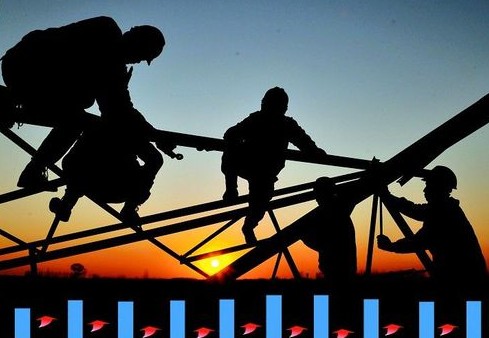The announcement of China’s gross domesticproduct figures this week hinted at the unwinding ofthe greatest growth narrative in history. From 1980to 2009, China expanded by an average of 10.1 percent annually, transforming the world’s mostpopulous country into its second-largest economy.Now though – Chinese officials said as theyannounced the slowest quarterly GDP growth ratesince the global financial crisis – we should prepareourselves for a “new normal” of slower expansion.This anodyne expression, however, camouflages anunsettling reality: there is nothing normal about the vast pit of debt from which China muststruggle to emerge.
中国本周发布的国内生产总值(GDP)数据,暗示着历史上最伟大的增长故事正在走向结局。从1980年到2009年,中国经济以年均10.1%的速度增长,让全球人口最众多的国家成长为全球第二大经济体。现在,中国官员在宣布自全球金融危机以来最低的GDP季度增长数据时表示,要对较低增长的“新常态”做好准备。然而,如此淡定平和的表述掩盖了一个令人不安的现实:中国现在的债务大坑绝不应该成为常态,它必须奋力从中跳出来。

Total Chinese debt has virtually doubled since the financial crisis to around 240 per cent ofGDP, according to Fitch, the credit rating agency. This means that debt service charges,assuming an average interest rate of 7 per cent, are set to reach about 17 per cent of thisyear’s prospective GDP, or $1.7tn. To put this number into perspective, it is likely thatChinese debtors – including its government, agencies, companies and individuals – will end uppaying an interest bill that is not far off the size of India’s GDP last year ($1.87tn) andconsiderably larger than the economies of South Korea ($1.3tn), Mexico ($1.26tn) andIndonesia ($870bn).
信用评级机构惠誉(Fitch)的数据显示,中国债务总额自全球金融危机以来几乎翻了一番,占到GDP的240%左右。这意味着,中国需要偿还的债务利息(假设平均利率为7%)将达到今年预计GDP的17%左右,即1.7万亿美元。也就是说,中国的债务人——包括政府、机构、公司和个人——最终偿还的债务利息很可能接近印度去年的GDP总值(1.87万亿美元),远远超过韩国(1.3万亿美元)、墨西哥(1.26万亿美元)和印尼(8700亿美元)等国的经济产值。
More germane to China, though, is the drag that such debts exert on domestic dynamism.The burden of debt service – measured as a proportion of GDP – remained well below thecountry’s growth rate during the blistering period of Chinese “catch-up” growth from 1980 until2009. Now, however, it stands at more than double the 7.3 per cent growth rate that theeconomy recorded in the third quarter. The implication of this is obvious: Chinese companiesand individuals are increasingly preoccupied with repaying loans and correspondingly lessinclined to invest or spend. In fact, the interest repayment burden has burgeoned so quicklythat it now matches the $1.7tn that private companies invested in factories and equipment inthe first nine months. It is also considerably more than the total invested so far this year onconstructing and buying real estate.
更重要的是,如此沉重的债务会削弱国内经济活力。从1980年到2009年“追赶性”增长期间,中国债务利息负担占GDP的比例远低于中国经济增速。然而,现在该比例是中国第三季度GDP增长率(7.3%)的两倍多。这样高的比例意味着:中国企业和个人越来越忙于应付偿还贷款,相应地就越来越不愿投资或支出。实际上,利息负担迅速增长,现在已相当于私营企业今年前9个月在厂房和设备上的投资总额,也远远超过了今年迄今房地产建设和购买总金额。
Debt fatigue is pernicious for an economy sustained by credit-fuelled investment. As GDPslows from 7.7 per cent last year while investment levels remain at 48 per cent of GDP, it isclear that China is deriving successively less “bang for its investment buck”. Herein lies thereason that Beijing appears less than likely to launch a round of debt-funded stimulus tobolster its sagging growth rate. Such a reprisal of its response to the financial crisis in 2009would merely exacerbate the credit fatigue that is hobbling its dynamism.
对一个依靠信贷驱动型投资维持的经济来说,“债务疲劳症” (Debt Fatigue)是有害的。GDP增长从去年的7.7%进一步放缓,同时投资水平依然占到GDP的48%,说明投资对经济增长的贡献在持续下降。正因为此,北京方面不太可能推出一轮由举债支持的刺激方案来提升低迷的增长率。2009年那种对金融危机报复性的回应只会加剧信贷疲劳症,侵蚀经济活力。
The problem for Beijing, though, is that the alternative to another round of stimulus is alsostrewn with pitfalls. Fitch estimates that if efforts to reduce an oversupply of real estatebrought the number of vacant properties back to 2008 levels from its current level of about28 per cent, it would haul GDP growth back to around 4 per cent – in line with most people’sdefinition of a “hard landing”.
然而,北京面临的问题在于,不出台新一轮刺激同样困难重重。惠誉估计,如果北京方面着力解决房地产过度供应问题,使住房空置率从当前的28%回落到2008年的水平,那么GDP增长可能降至4%左右的水平——这已符合大多数人对“硬着陆”的定义。
Thus it will require no small measure of nerve on Beijing’s part to navigate between anunsustainable credit splurge and a collapse in domestic demand that would hammerresource-exporting economies the world over. Nevertheless, the course that China has settoward reform, complemented by a squeeze on credit and overcapacity, is the only practicaloption. The alternative would be to continue feeding China’s unsustainable debt addiction.Just do not expect the “new normal” to be free from drama.
因此,北京方面将需要具备不小的魄力,在不可持续的放贷热潮和国内需求崩溃之间寻找出路。如果中国国内需求崩溃,将会打击世界各地的资源出口国。然而,对中国来说,制定改革路线,再辅以紧缩信贷和削减过度产能,是目前唯一现实的选择。否则中国就会在不可持续的举债刺激的道路上越走越远。别以为“新常态”就会安安稳稳的。
本文关键字: FT社评 中国转向"新常态"之痛
 免费试听
免费试听

时长 : 29:45 主讲 : 乔迪

时长 : 44:09 主讲 : 徐宸

时长 : 21:15 主讲 : 徐宸

时长 : 21:15 主讲 : 徐宸

时长 : 44:09 主讲 : 徐宸

时长 : 29:45 主讲 : 乔迪

时长 : 15:31 主讲 : 徐新磊

时长 : 18:37 主讲 : 孔令金

时长 : 15:31 主讲 : 徐新磊
 推荐阅读
推荐阅读
第十三届全国人民代表大会第二次会议(the second session of the 13th National People& 39;s Congress)5日上午在人民大会堂开
第十三届全国人民代表大会第二次会议(the second session of the 13th National People& 39;s Congress)5日上午在人民大会堂开
第十三届全国人民代表大会第二次会议(the second session of the 13th National People& 39;s Congress)5日上午在人民大会堂开
第十三届全国人民代表大会第二次会议(the second session of the 13th National People& 39;s Congress)5日上午在人民大会堂开
第十三届全国人民代表大会第二次会议(the second session of the 13th National People& 39;s Congress)5日上午在人民大会堂开
第十三届全国人民代表大会第二次会议(the second session of the 13th National People& 39;s Congress)5日上午在人民大会堂开
第十三届全国人民代表大会第二次会议(the second session of the 13th National People& 39;s Congress)5日上午在人民大会堂开
第十三届全国人民代表大会第二次会议(the second session of the 13th National People& 39;s Congress)5日上午在人民大会堂开
第十三届全国人民代表大会第二次会议(the second session of the 13th National People& 39;s Congress)5日上午在人民大会堂开
第十三届全国人民代表大会第二次会议(the second session of the 13th National People& 39;s Congress)5日上午在人民大会堂开
